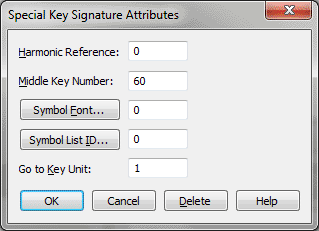Special Key Signature Attributes dialog box

How to get there
- Click the Key Signature tool
 , and double-click the measure in which you want the key
to change.
, and double-click the measure in which you want the key
to change.
- The Key Signature dialog box appears. (There are a variety
of other ways to access this dialog box.)
- Choose Nonstandard from the
drop-down list.
- Click the Attribute icon.
What it does
This dialog box concerns the creation of
linear key formats and nonlinear key signatures; see Nonstandard
Key Signature dialog box for a more complete discussion. In brief,
Finale lets you create nonstandard key systems and key signatures, based
on scales with any number of steps, and with accidentals placed in any
order you want.
For any such key system you create, you
can specify a number of special attributes, such as the symbols you want
to use in the key signature (instead of the flat and sharp symbols).
- Harmonic
Reference. The number in this text box identifies the note that
all other dialog boxes in Finale’s key system will consider to be the
C, or fundamental root tone. Enter zero for C, 1 for D, 2 for E, and so
on. There’s little reason ever to change the default setting in this text
box (zero, or C).
- Middle
Key Number. The number in this text box specifies the MIDI key
number that corresponds to the Harmonic Reference number. (In the MIDI
key numbering system, the keys on a synthesizer are numbered sequentially
from bottom to top. Middle C is note 60, C sharp is 61, and so on.)
You can use this parameter to good advantage
if you want to transform your synthesizer into a transposing synthesizer
(as far as Finale is concerned). For example, if you set the Middle Key
Number to 48 (C below middle C), Finale will interpret every note you
play as a note an octave higher; likewise, when Finale plays back a score,
it will play notes on your synthesizer an octave lower than written.
- Symbol
Font. The number in this text box corresponds to the font which
has the symbols you want to use for accidentals. To choose a new font,
click Symbol Font; Finale displays the Font dialog box, from which you
can choose the new font.
- Symbol
List ID. The number in this text box identifies a symbol list you’ve
created— an array of accidental Amounts (where one sharp has an Amount
of 1, one flat has an Amount of –1, and so on) and corresponding characters
you want to appear in the key signature to represent them. To create a
symbol list, click Symbol List ID; the Symbol List dialog box appears,
in which you can define the character you want to appear in place of the
usual sharp, flat, double-sharp, or other standard symbol. (See Symbol
List dialog box.)
- Go
to Key Unit. Enter a number in this text box to specify the number
of scale steps Finale should consider to be between each pair of keys
on your MIDI keyboard. In other words, if you’ve specified a quarter-tone
scale, tell Finale that the Key Unit is 2—there are two scale tones, not
one, between one synthesizer key and the next. (If your synthesizer can
produce quarter tones, however, leave the Key Unit at 1, so that Finale
will correctly play back your quarter-tone score.) If you’ve specified
the correct Key Unit value, Finale will transcribe and play any music
performed in the usual way correctly. If you created a quarter-tone scale
without changing the Key Unit, by contrast, you’d have to drastically
modify your playing style.
- Delete.
Click Delete to restore all the settings in this dialog box back to their
default "traditional" values.
- OK
• Cancel. Click OK to confirm, or Cancel to discard, the settings
you’ve made in this dialog box. You return to the Nonstandard Key Signature
dialog box.
See Also:
Nonstandard Key
Signatures
Key Signature
Tool

